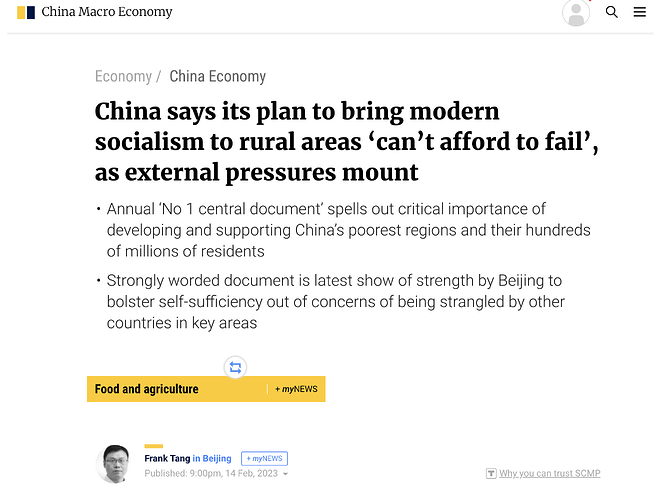中国已承诺确保农业供应,创造农村就业机会,并使进口多样化。
这是由于地缘政治的不确定性和确保国内供应和发展的需要。
政府的 "中央一号文件 "已经发布,将农村工作列为优先事项。
这份文件反映了中国在关键领域可能被其他国家扼杀的变化中的世界。
根据该文件,保持农业、农村和农民的基本面至关重要。
不确定和不可预测的因素正在增加,因此,在这项工作中不能失败。
北京在农村工作方面划定了两条底线:粮食安全和防止大规模返贫。
中国的大部分大豆、玉米和油菜籽都是进口的,但与美国的紧张关系和市场动荡已经引起了警觉。
北京已经采取了战略措施,在增加国内供应的同时实现进口的多样化。
当局计划制定一部粮食安全法,并深化国家的进口多元化战略。
中国人民大学经济学院的刘守英说,保证粮食供应是一个战略考虑和安全问题。
确保粮食安全是实现现代化和防止大规模返贫的关键。
这是一个战略考虑和安全问题,新政府必须管理风险和外部逆风以实现这些目标。
2021年中国进口1.469亿公吨谷物,比2021年下降10.7%。
北京已经设定了2023年国内粮食生产6.5亿公吨的目标。
政府正在发起一项倡议,通过种子和技术,以及补贴和激励措施,将粮食产能扩大5000万公吨。
地方政府已经被分配了各自的生产配额,如果没有达到配额,官员将被追究责任。
西南省份云南已经披露了20多起与粮食有关的腐败案件。
中央政府正在鼓励农村居民向工业或服务部门迁移,特别是那些已经摆脱了极端贫困的人。
中国的目标是成为一个农业大国,拥有充足的粮食供应、技术设备,以及工业的弹性和竞争力。
政府正在对粮食生产、储存和销售过程进行高调的调查。
正在鼓励农村居民在工业或服务部门寻求就业,以增加他们的收入。
中国的领导层说,绝对贫困已经基本消除了。
官方数据显示,城乡差距已经缩小,农民的平均可支配收入增长了4.2%。
世界银行为中上收入国家制定的2022年贫困线估计,约有2.73亿人,或其人口的19%,低于这一水平。
北京计划加强省级合作,将农村劳动力从西部贫困省份移植到沿海工厂。
一号文件说,它将把政府扶贫计划下的劳动力规模保持在3000万以上。
中央农村工作领导小组办公室副主任吴宏耀发誓要在县一级创造更多的就业机会。
农村居民的收入中约有42%来自于移民工作。
国家发展和改革委员会鼓励在当地项目中使用当地人力,以使这些工人留在他们的家乡并获得更多收入。
中国去年有2.956亿农民工,其中58%是在家乡以外的地方就业。
China has pledged to ensure agricultural supplies, create rural jobs and diversify imports.
This is due to geopolitical uncertainties and the need to ensure domestic supplies and development.
The government’s “No 1 central document” has been released to prioritize rural work.
This document reflects the changing world in which China could be strangled by other countries in key areas.
According to the document, the need to maintain the fundamentals of agriculture, rural areas and farmers is vital.
Uncertain and unpredictable factors are increasing, making it essential to not fail in this endeavor.
Beijing has drawn two bottom lines in terms of rural work: grain security and the prevention of a large-scale return to poverty.
China imports most of its soybean, corn and rapeseed, but tensions with the US and market turbulence have set off alarms.
Beijing has responded by making strategic moves to diversify imports while increasing domestic supply.
Authorities plan to enact a grain-security law and deepen the nation’s import-diversification strategy.
Liu Shouying of Renmin University’s School of Economics says that guaranteeing grain supplies is a strategic consideration and a security issue.
Ensuring grain security is key in modernisation and preventing a large-scale return to poverty.
It is a strategic consideration and a security issue, and the new government will have to manage risks and external headwinds to achieve these goals.
China imported 146.9 million metric tonnes of grains in 2021, down 10.7% from 2021.
Beijing has set a goal of 650 million metric tonnes of domestic grain production in 2023.
The government is launching an initiative to expand grain capacity by 50 million metric tonnes through seed and technology, and subsidies and incentives.
Local governments have been assigned respective production quotas, and officials will be held accountable for failure to meet them.
The southwestern province of Yunnan has already disclosed more than 20 grain-related corruption cases.
The central government is encouraging rural residents to migrate to industrial or service sectors, particularly those who have been lifted out of extreme poverty.
China is aiming to become an agricultural superpower with sufficient grain supplies, technological equipment, and industrial resilience and competitiveness.
The government is making high-profile investigations into the grain production, storage and sales process.
Rural residents are being encouraged to seek employment in industrial or service sectors to increase their revenue.
China’s leadership has said that absolute poverty has been largely eradicated.
Official data shows that the urban-rural gap has narrowed with the average disposable income of farmers rising 4.2%.
The World Bank’s 2022 poverty line for upper middle-income countries estimates that around 273 million people, or 19% of its population, are below that level.
Beijing plans to enhance provincial cooperation to transplant rural labour from poor western provinces to coastal factories.
The No 1 document said it will keep the labour size under the government’s anti-poverty programme at above 30 million.
Wu Hongyao, deputy director of the office of the central leading group for rural work, vowed to create more jobs at county levels.
About 42% of rural residents’ revenue comes from migrant jobs.
The National Development and Reform Commission encourages the use of local manpower in local projects to keep those workers in their hometowns and earn more revenue.
China had 295.6 million rural migrant workers last year, 58% of whom were employed outside of their hometowns.
